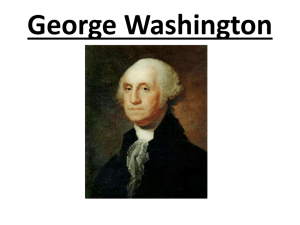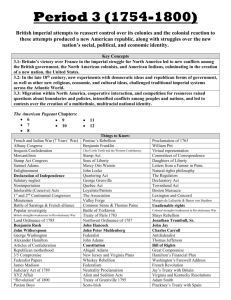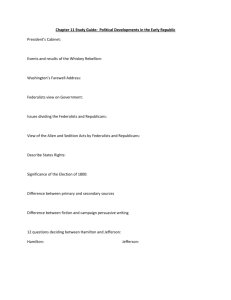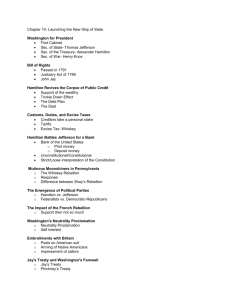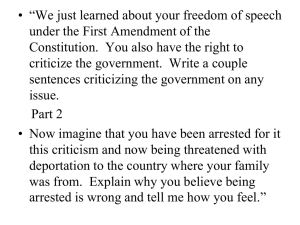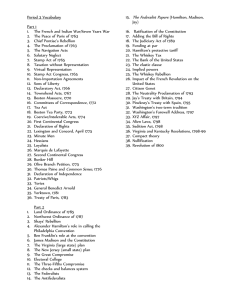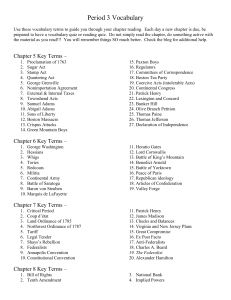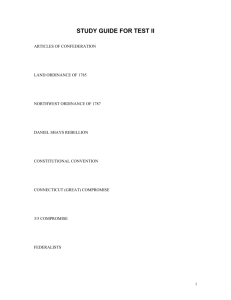APUSH Exam Review Time Period: 3 Period 3: 1754
advertisement
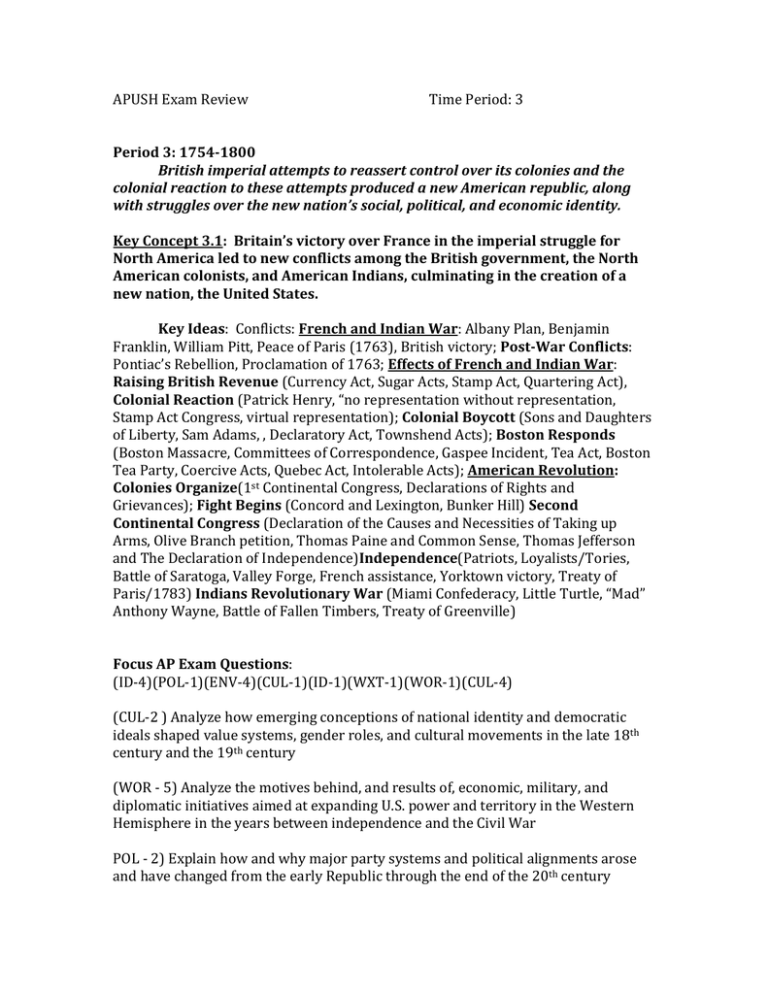
APUSH Exam Review Time Period: 3 Period 3: 1754-1800 British imperial attempts to reassert control over its colonies and the colonial reaction to these attempts produced a new American republic, along with struggles over the new nation’s social, political, and economic identity. Key Concept 3.1: Britain’s victory over France in the imperial struggle for North America led to new conflicts among the British government, the North American colonists, and American Indians, culminating in the creation of a new nation, the United States. Key Ideas: Conflicts: French and Indian War: Albany Plan, Benjamin Franklin, William Pitt, Peace of Paris (1763), British victory; Post-War Conflicts: Pontiac’s Rebellion, Proclamation of 1763; Effects of French and Indian War: Raising British Revenue (Currency Act, Sugar Acts, Stamp Act, Quartering Act), Colonial Reaction (Patrick Henry, “no representation without representation, Stamp Act Congress, virtual representation); Colonial Boycott (Sons and Daughters of Liberty, Sam Adams, , Declaratory Act, Townshend Acts); Boston Responds (Boston Massacre, Committees of Correspondence, Gaspee Incident, Tea Act, Boston Tea Party, Coercive Acts, Quebec Act, Intolerable Acts); American Revolution: Colonies Organize(1st Continental Congress, Declarations of Rights and Grievances); Fight Begins (Concord and Lexington, Bunker Hill) Second Continental Congress (Declaration of the Causes and Necessities of Taking up Arms, Olive Branch petition, Thomas Paine and Common Sense, Thomas Jefferson and The Declaration of Independence)Independence(Patriots, Loyalists/Tories, Battle of Saratoga, Valley Forge, French assistance, Yorktown victory, Treaty of Paris/1783) Indians Revolutionary War (Miami Confederacy, Little Turtle, “Mad” Anthony Wayne, Battle of Fallen Timbers, Treaty of Greenville) Focus AP Exam Questions: (ID-4)(POL-1)(ENV-4)(CUL-1)(ID-1)(WXT-1)(WOR-1)(CUL-4) (CUL-2 ) Analyze how emerging conceptions of national identity and democratic ideals shaped value systems, gender roles, and cultural movements in the late 18th century and the 19th century (WOR - 5) Analyze the motives behind, and results of, economic, military, and diplomatic initiatives aimed at expanding U.S. power and territory in the Western Hemisphere in the years between independence and the Civil War POL - 2) Explain how and why major party systems and political alignments arose and have changed from the early Republic through the end of the 20th century Key Concept 3.2: In the late 18th century, new experiments with democratic ideas and republican forms of government, as well as other new religious, economic, and cultural ideas, challenged traditional imperial systems across the Atlantic World. Key Ideas: Impact of Enlightenment: Ideas of John Locke, revolutionary spirit; The Articles of Confederation: Strengths/Weaknesses, New Set of Laws (Land Ordinance of 1785, Northwest Ordinance of 1787), Shay’s Rebellion (Daniel Shays and farmers, failure of articles, James Madison and Alexander Hamilton – whig fears) Constitutional Convention: Post War Problems (challenges to sovereignty with Britain, Spain, and France, Barbary Pirates), Madison takes charge (central government, separation of powers, advocated a strong central government) Great Compromise (Virginia Plan, New Jersey Plan, House of Representatives, Senate) Executive Decision and 3/5 Compromise (President elected by Electoral College, fear of mobocracy, representation problems with slavery, Three-Fifths Compromise and the Northwest Ordinance); Debate over Ratification: Federalists, Anti-Federalists, Bill of Rights, The Federalists Papers; Structuring the New Republic: First Cabinet (Washington, Adams, Jefferson, and Hamilton, Judiciary Act of 1789) Hamilton and Finances (excise taxes, “funding at par”, assumption of state debts, Revenue Act of 1789), Bank of US (Bank of United States, strict constructionist, loose constructionist, “elastic” cause, rise of the party system/Federalists vs Democratic-Republicans); Foreign Policy ( French Revolution, Neutrality Proclamation of 1793, Jay’s Treaty with Great Britain, Pinckney’s Treaty with Spain, Farewell Address) Focus AP Exam Questions: (ID-1)(WOR-2)(CUL-4)(WOR-5)(ID-4)(CUL-2) [POL - 5) Analyze how arguments over the meaning and interpretation of the Constitution have affected U.S. politics since 1787 (WXT - 6) Explain how arguments about market capitalism, the growth of corporate power, and government policies influenced economic policies from the late 18th century through the early 20th century (POL - 5) Analyze how arguments over the meaning and interpretation of the Constitution have affected U.S. politics since 1787 Key Concept 3.3: Migration within North America, cooperative interaction, and competition for resources raised questions about boundaries and policies, intensified conflicts among peoples and nations, and led to contests over the creation of a multiethnic national identity. Key Ideas: Internal Issues Facing the New Government: Native American attacks (Battle of Fallen Timbers, Miami Confederacy, contact with French and British allies) Insurrection by Angry Citizens (Shay’s Rebellion), Settlement of newly acquired land (Public Land Act of 1796) Adams as Second President: XYZ Affair (French ambassadors, XYZ affair, Federalist reaction to war, Convention of 1800 ended problems with France) Alien and Sedition Acts (Federalists vs DemocraticRepublicans, Alien Acts, Sedition Act, nullification by states, compact theory); The Revolution of 1800: Election of TJ (mudslinging campaign, Electoral College tied Hamilton convinces the House to reject Aaron Burr(VP candidate for Adams); Louisiana Purchase: Negotiations with Napoleon (land from Spain, New Orleans from Pinckney Treaty, rebellion in Haiti, war in Europe, Little Nap need $$$); Lewis and Clark (St. Louis to Pacific, mapped out territory) Focus AP Exam Questions: (ID – 5) (PEO-5) (POL-1)(WOR-1)(WOR-5)(POL-4)(WXT – 2) (WXT-4)(POL-2) (CUL-2) (ENV - 3) Analyze the role of environmental factors in contributing to regional economic and political identities in the 19th century, and how they affected conflicts such as the American Revolution and the Civil War
